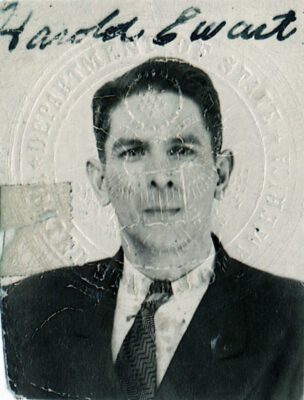Growing up I remember my mom carrying around her father’s seaman passport photo. It was one of only a few she had of him. He died young, at age 31 of tuberculosis.1 I remember the photo distinctly; it was black and white with a raised seal and his signature. Not knowing much about him or having many heirlooms, I can see why Mom carried it around and showed it to us whenever we were curious about him.
I hoped his passport would reveal a history of his travels, but it lacked the typical stamps of a seasoned mariner. Instead, this document reflects his critical choices and marks a pivotal moment in his career, revealing a deeper narrative than his travels.

The Passport:
My grandfather, Harold Ewart was born on 10 December 1915 in England to Harold Parker Ewart and Mary Annie Telford.2 His father, a merchant mariner, moved the family to the United States in 1919.3 Harold became a merchant mariner like his father. He worked as a fireman and oiler on tankers such as the Swifscout, the Malmaton, and the Swiftlight between 1934 and 1943.4 Although the passport doesn’t tell us this, he traveled to places like Abadan, Iran, a key hub for oil shipping.5
This type of Seaman Passport is rather unique. As part of his job, Harold needed to carry around his certificate of identification. The Department of State issued these passports as a wartime measure between February 23, 1942, and August 28, 1945. 6 Harold’s passport was issued on June 28, 1944. Although the passport provides limited details about my grandfather, it includes his physical features, date and place of birth, a photo, his signature, and thumbprints.
- Height: 5 feet 10 inches
- Hair: Brown
- Eyes: Blue
- Distinguishing Marks: Scar on Left Hand
- Place of Birth: England
- Date of Birth: Dec. 10, 1915
The rest of the book is empty, with no endorsements. This isn’t because he didn’t travel during his time as a merchant seaman, but because he chose not to continue his career after the passport was issued, which explains the absence of border stamps. While the passport doesn’t reflect Harold’s service as a mariner, it instead marks the end of his maritime career.
Career Choices:
Harold failed to join his ship, the S.S. Exford, out of New York on June 1, 1944. 7 His actions earlier that year suggest he was still on track, applying for a replacement identification for one he had lost, and signing articles to join the S.S. Exford in May. 8
What changed his mind remains unknown. But life for mariners meant long, dangerous trips at sea, and work was intermittent. Perhaps he was needed at home, had health issues, found steady work, or maybe he was growing weary of the dangers of wartime service. The casualty rate for mariners was extremely high and more mariners were killed during World War II than any branch of the military. 9 I wrote about such dangers in an article about his father’s service.
According to Howard William Pfieffer, an able-bodied seaman who joined the S.S. Exford for that journey, some mariners felt the Exford was “a piece of crap.” At least one man that day said he wouldn’t board. Loaded with one-ton bombs and without a full crew, the ship indeed broke down two days out. After repairs, the ship rejoined their convoy, unloaded the bombs in Liverpool, and set out for Omaha Beach. Under heavy artillery, the ship was deliberately scuttled [sunk] during the Invasion of Normandy. 10 Omaha was the most heavily defended area and the most deadly – Harold’s decision not to go may have saved his life.
Labeled a “deserter,” Harold was reported to the shipping commission. Although wartime conditions may have imposed higher standards, mariners were still civilians and were free to quit their jobs at any time without penalty. 11 No action was taken against him. Although he lost his pay of $16.11 he could have joined another ship if he wanted to. 12 I wonder how my grandmother felt about this—was she upset over the lost pay, or relieved that he avoided a dangerous journey at sea?”
Harold Ewart’s seaman passport is more than just a travel document; it is a cherished memento of a life cut short, and a testament to our family’s maritime legacy. Tragically Harold died just a few years later in 1947 leaving behind his pregnant wife. For my mother, it was a tangible connection to her father, a man she never knew. For me, it offers a glimpse into the life of a man who braved the seas during tumultuous times. In preserving this passport, we honor his memory and ensure that future generations remember his story.











